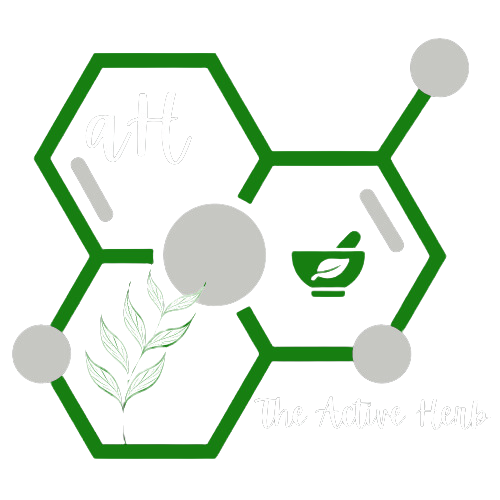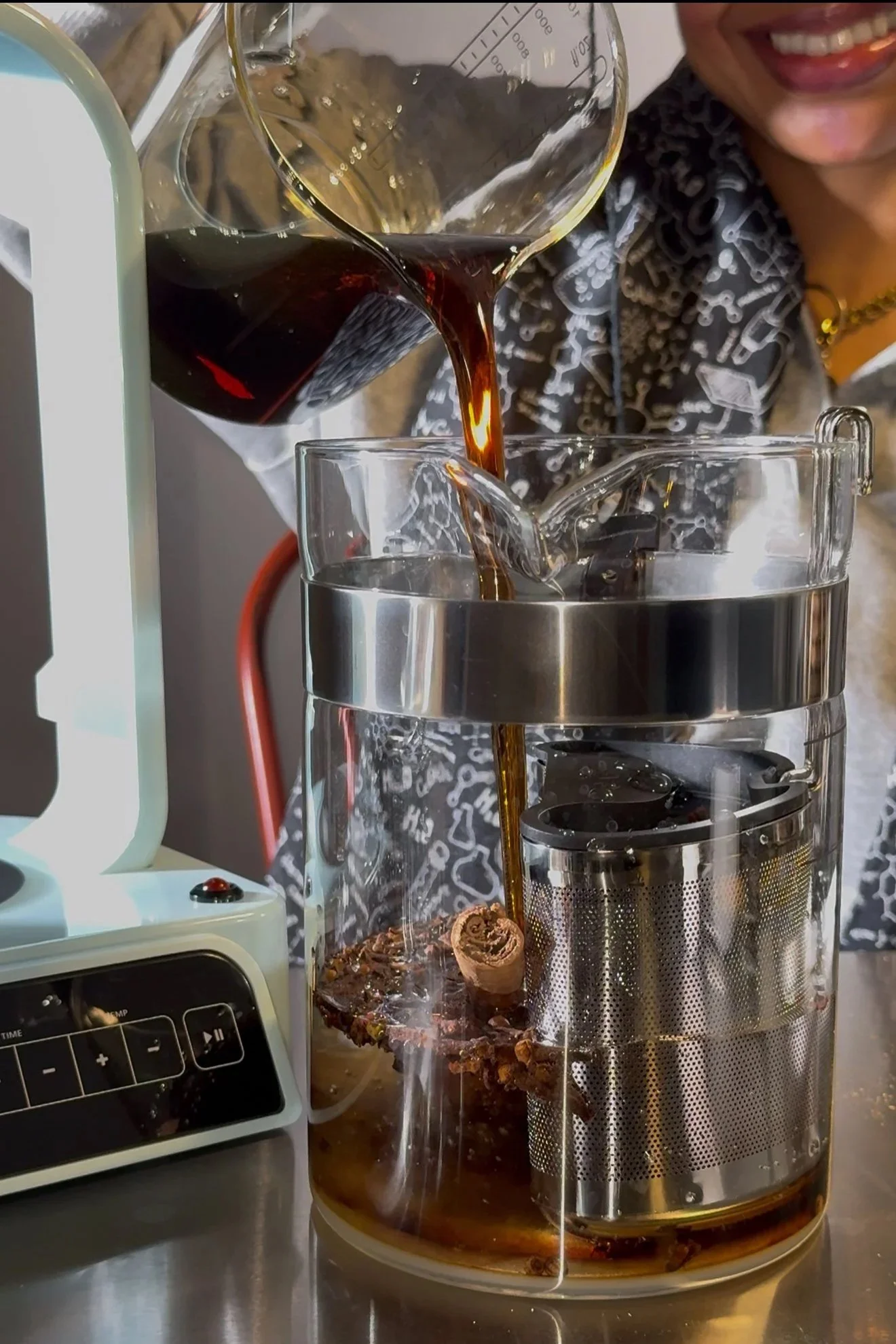Elderberry Syrup: A Sweet Little Lesson in Plant Science
Elderberry Syrup in the LEVO C
Precision heat. Perfect extraction.
Elderberries, ginger, and rosehips infuse evenly—no scorching, no guessing—just a rich, antioxidant-packed syrup that keeps its color, potency, and flavor.
There’s something quietly magical about making elderberry syrup. It simmers and steams, perfuming your kitchen with dark fruit and warm spice, but beneath the cozy scent is a full-blown biochemical event. Each ingredient interacts with your body on a molecular level, antioxidants regulating gene expression, enzymes influencing membrane stability, phenolics altering microbial behavior. In other words, it’s not just sweet—it’s science in a bottle.
Let’s unpack what makes this herbal classic so powerful, how to make it safely, and a few clever ways to customize it for deeper synergy.
Why Elderberries Need Heat
Elderberries (Sambucus nigra) are loaded with anthocyanins, flavonols, and phenolic acids that protect your cells from oxidative stress and support immune balance. But raw elderberries also contain cyanogenic glycosides, natural compounds that can release cyanide when metabolized. Gentle heat deactivates those glycosides and denatures lectins, making the berries perfectly safe while improving nutrient extraction.
Heat also softens the plant cell walls, allowing more anthocyanins, quercetin glycosides, and polysaccharides to dissolve into the water. Think of it as a controlled release of the plant’s chemistry into solution.
A 30 to 45-minute simmer (never a hard boil) is the sweet spot, long enough to neutralize toxins, not long enough to destroy delicate compounds.
Elderberries (Sambucus nigra)
Rich in anthocyanins and flavonoids that protect cells, balance inflammation, and support immune defense. Best used gently heated to unlock their full potency.
The Base Ingredients and What They’re Doing at the Cellular Level
Elderberry (Sambucus nigra)
Rich in anthocyanins, these pigments neutralize reactive oxygen species and help stabilize mitochondrial membranes. Elderberry extracts also interact with viral hemagglutinin proteins, preventing viruses from docking onto host cells. The flavonoids in elderberry upregulate the Nrf2 pathway, a master regulator of antioxidant gene expression, effectively telling your body to make more of its own protective enzymes.
Ginger (Zingiber officinale)
Ginger’s fiery compounds — gingerols and shogaols — activate transient receptor potential (TRP) ion channels, enhancing circulation and modulating inflammatory cytokines. They also improve nutrient transport across capillary walls and influence calcium signaling in immune cells, essentially helping your body’s defenses communicate better.
Rosehips (Rosa canina)
Rosehips supply vitamin C in tandem with carotenoids and galactolipids that stabilize collagen fibers and reduce lipid oxidation. Vitamin C here acts as a cofactor for enzymes that repair connective tissue and regenerate oxidized antioxidants, creating a recycling system that keeps your antioxidant network running efficiently.
Cloves (Syzygium aromaticum)
Eugenol, the primary active in cloves, interacts with lipid membranes, helping to maintain fluidity while also disrupting microbial enzyme activity. It’s a phenolic compound with anesthetic, anti-inflammatory, and preservative properties that extend the syrup’s shelf life.
Star Anise (Illicium verum)
Contains shikimic acid, the same molecule that underpins the synthesis of certain antiviral medications. Shikimic acid feeds into the shikimate pathway, essential for building phenolic compounds in plants and indirectly beneficial to human immune modulation.
Ceylon Cinnamon (Cinnamomum verum)
Cinnamaldehyde enhances glucose uptake in cells and increases mitochondrial respiration. Polyphenols in Ceylon cinnamon can also disrupt bacterial quorum sensing, the system microbes use to “talk” and form biofilms, giving it quiet antimicrobial influence on gut flora balance.
Peppercorns (Piper nigrum)
Piperine boosts the bioavailability of other plant compounds by inhibiting enzymes such as CYP3A4 and P-glycoprotein. This means the antioxidants and polyphenols in your syrup stay active in the bloodstream longer, increasing their cellular reach.
Maple Syrup (Acer saccharum)
Far from being just sweet, maple syrup provides minerals like zinc and manganese that support antioxidant enzyme systems (especially superoxide dismutase). It also contributes phenolic acids that synergize with the elderberry’s anthocyanins, reinforcing stability and flavor.
Raw Honey
Honey’s enzymes, particularly glucose oxidase, slowly release trace amounts of hydrogen peroxide, creating a mild antiseptic effect. It coats mucosal membranes, allowing plant compounds to linger and absorb through buccal tissues. The fructose and glucose provide immediate and sustained energy to immune cells in high-demand states.
Water
The simplest ingredient is also the most essential. Good quality, filtered or spring water ensures that metal ions or chlorine don’t interfere with plant chemistry. It dissolves the hydrophilic compounds, vitamin C, anthocyanins, glycosides, creating a stable, bioavailable infusion.
The Basic Recipe
1 cup dried elderberries
1 tablespoon dried rosehips
1 tablespoon sliced fresh ginger
3 cloves
1 star anise
1 stick Ceylon cinnamon
½ teaspoon peppercorns
3 cups filtered water
½ cup pure maple syrup
¼ cup raw honey
Simmer the herbs and spices (except the sweeteners) in water for about 45 minutes, until the liquid is reduced by half. Strain through a fine mesh or cheesecloth. When the mixture cools to warm (not hot), stir in the maple syrup and honey. Store in the refrigerator for up to three weeks.
Optional Synergistic Additions
Each addition tweaks the syrup’s molecular personality. These plants can amplify the base chemistry, offering additional pathways of support.
Licorice Root (Glycyrrhiza glabra)
Licorice root’s glycyrrhizin slows cortisol breakdown, supporting the stress response and adrenal balance. It also increases mucosal hydration, making it excellent for soothing the throat or dry respiratory passages.
Echinacea Root (Echinacea purpurea)
Packed with alkylamides that activate macrophages and dendritic cells — immune sentinels that initiate pathogen defense. When paired with elderberry, echinacea supports a balanced, well-timed immune response rather than overstimulation.
Lemon Peel (Citrus limon)
Adds flavonoids like hesperidin and rutin, which improve vitamin C uptake and strengthen capillary walls. Its volatile oils have mild antibacterial and anti-inflammatory actions.
Thyme (Thymus vulgaris)
Rich in thymol and carvacrol, thyme has powerful phenolic compounds that disrupt microbial membranes and biofilms. It supports the respiratory tract and complements elderberry’s antioxidant chemistry.
Oregano (Origanum vulgare)
Shares thymol and carvacrol with thyme but in a slightly stronger, more aromatic balance. It helps modulate gut flora and reduce bacterial adhesion.
Elderflower (Sambucus nigra flower)
Brings lighter flavonoids like rutin and apigenin, which aid microcirculation and act as gentle diaphoretics — supporting the body’s natural temperature regulation.
Lemon Balm (Melissa officinalis)
Contains rosmarinic acid that influences GABA neurotransmission, calming the nervous system. It also helps regulate digestive tone, balancing ginger’s stimulation.
Schisandra Berries (Schisandra chinensis)
Adaptogenic berries rich in lignans that support liver detoxification and mitochondrial resilience. They enhance cellular oxygen use, adding an energizing undertone to the syrup.
Turmeric Root (Curcuma longa)
Curcumin activates the Nrf2 pathway and suppresses NF-κB, balancing antioxidant production with inflammation control. Combined with the pepper already in the recipe, its bioavailability dramatically increases.
Creative Preparation Options
Slow Infusion (LEVO or Double Boiler)
A slow, low-heat extraction preserves volatile compounds like eugenol and cinnamaldehyde while still neutralizing elderberry glycosides. This method yields a smoother, more aromatic syrup.
Cold Steep, Warm Finish
Let the herbs and spices steep in cold filtered water for 24 hours in the refrigerator, then gently warm to just below a simmer. This preserves delicate compounds like vitamin C while still creating a shelf-stable product once the sweeteners are added.
Alcohol or Glycerin Finish
After cooling, add a tablespoon of brandy or vegetable glycerin to extend shelf life. Alcohol extracts lipid-soluble constituents, while glycerin lends smoothness and microbial stability.
Elderberry Syrup Making with the LEVO C: Precision Meets Tradition
Crafting elderberry syrup with the LEVO C takes the guesswork out of one of herbalism’s most chemistry-dependent recipes. Traditional stovetop simmering can easily run too hot or too long, degrading delicate anthocyanins and vitamin C. The LEVO C’s controlled temperature and timed infusion function solve that by maintaining the perfect extraction range for phenolic compounds, polysaccharides, and aromatic oils.
Inside the pod, dried elderberries, sliced ginger, and rosehips gently rehydrate and release their anthocyanins, flavonoids, and organic acids into the water–maple base. The full-size glass chamber allows you to add whole spices—cloves, star anise, Ceylon cinnamon, and peppercorns—that infuse their volatile oils evenly throughout the liquid. Because the LEVO C infuses under consistent heat and mild circulation, the extraction is uniform and oxidation is minimized, resulting in a syrup that is both vibrant in color and potent in antioxidant activity.
The controlled heat is particularly important for elderberries. It’s warm enough to denature the cyanogenic glycosides and lectins naturally present in raw berries, compounds that can irritate the digestive system if left intact, yet gentle enough to preserve anthocyanin stability. The result is a syrup that’s safe, deeply pigmented, and biochemically active.
When the infusion completes, the built-in filtration system separates the liquid from the botanical solids, so you’re left with a clean, concentrated extract ready to sweeten. Stir in raw honey once the mixture cools to warm, preserving honey’s live enzymes, or blend in maple syrup for added trace minerals.
The LEVO C turns elderberry syrup making into a precision-guided experiment, part kitchen craft, part laboratory process. You get the traditional depth of flavor and the full spectrum of plant compounds without hovering over a stove, and the finished syrup retains its antioxidant capacity, fragrance, and silky texture batch after batch.
Putting It All Together
When you make elderberry syrup with attention to both chemistry and craft, you’re creating more than a wellness tonic. You’re orchestrating an exchange between molecules that support each other, anthocyanins that protect mitochondria, phenolics that stabilize membranes, enzymes that preserve the whole system.
The syrup you bottle is, in truth, a network of biological conversations, between plant and cell, sugar and acid, tradition and science. The next time you pour a spoonful, think of it as liquid evidence that flavor, function, and molecular design can happily coexist in one jar.



